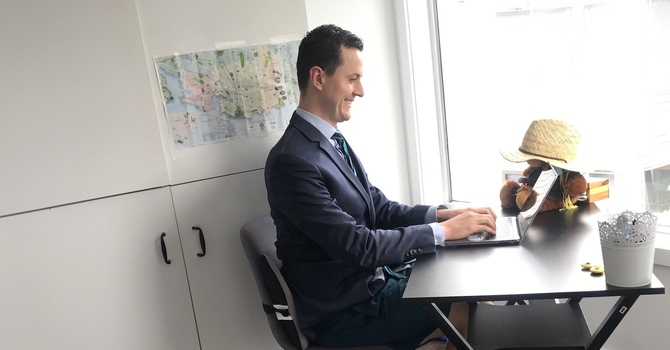The Lowdown on LBP: Putting Low Back Pain Behind You

Dr. Marc Bijman, BSc HK, DC
|
--12 minute read -- |
Low back pain (LBP) is one of the most common health problems worldwide, affecting millions (probably billions) of people worldwide every day. It ranges from a subtle ache to severely debilitating, making even the strongest among us crumble to our knees in agony.
As someone who has seen and even experienced LBP on multiple occasions, I can attest to the fact that it can be a frustrating and challenging condition to deal with. However, there is hope. With proper knowledge and guidance, LBP can be prevented and treated effectively.
In this guide, we will explore low back pain, its causes, prevention & treatment options, and explore future direction.
What is Low Back Pain?
If you've ever experienced low back pain, you know it's like an unwelcome guest who just won't take the hint and leave. It's the kind of guest who eats all your snacks and monopolizes the conversation, leaving you and the others signalling to each other - "When will they leave?!". LBP can be very disruptive to one's life, and pain can range from mild discomfort to "I can't even stand up straight" agony. Low back pain (LBP) is a prevalent health problem affecting people of all ages worldwide. It is the leading cause of disability globally and can significantly impact an individual's quality of life. According to a recent Lancet Series on LBP, there has been a significant increase in the burden of LBP over the past few decades, with a significant impact on healthcare costs.
Acute
Acute back pain is a sudden onset of discomfort or pain in the lower back that usually lasts for a short period of time. This type of pain can range from mild to severe and can sometimes be accompanied by muscle spasms, stiffness, or limited range of motion. While acute back pain can be alarming and uncomfortable, it often resolves on its own with conservative treatment such as rest, ice or heat therapy, and over-the-counter pain medications. However, it is important to seek medical attention if the pain is severe, accompanied by other symptoms, or does not improve within a few days.
Chronic
Chronic back pain, on the other hand, is defined as pain that lasts for more than three months. It is typically worsened by psychosocial factors such as chronic stress, mental health conditions and poor lifestyle choices. Chronic back pain can significantly impact a person's quality of life, causing them to miss work, social activities, and daily tasks. For this, you definitely want to get assessed by a medical professional.
Causes of Low Back Pain
Low back pain (LBP) is a common condition that affects many individuals. LBP can come from a physical cause, including anything from muscle strains to herniated discs to degenerative conditions - this we term "biological". We'd be remiss, though, if we didn't talk about the other two aspects of back pain - social and psychological factors. Together, they form the trifecta - Biopsychosocial, to which all pain (not just lower back pain) can be attributed to.
Biological
Biological causes of back pain are likely caused by an injury or aggravation of a tissue. 3 examples include muscle strains, disc injuries or degenerative conditions.
Muscle strains, for example, can be caused by overuse or sudden movements and cause the muscles to seize. This can range from mild to severe, depending on the extent of the tissue damage.
A herniated disc is when the inside of the disc herniated (or bulges) past the inner layer. Herniated discs can result from car accidents, poor posture, lifting, or just bad luck.
Lastly, degenerative conditions like arthritis and stenosis can cause the spinal canal to narrow, putting pressure on the nerves that run through the lower back. This pressure can result in pain, numbness, and weakness downstream of the nerve. If the issue is in the lower back, likely the lower back, legs and feet are affected. If the issue is in the neck than the neck, arm, and hands could be compromised.
Social
Other factors that can contribute to LBP include obesity, occupation, and lack of sleep.
Obesity is a widely recognized risk factor for lower back pain (LBP) due to the additional stress that excess body weight places on the spine. This can cause structural changes in the spine and increased pressure on the intervertebral discs, leading to pain and discomfort. This is considered is now considered a social issue, more so than a biological one.
Another factor that can contribute to lower back pain is occupation. Jobs that require prolonged sitting or standing, heavy lifting, or repetitive motions can put excessive strain on the lower back, leading to discomfort or pain. Truck drivers, construction workers, and healthcare professionals, for example, are all at increased risk for developing lower back pain due to the physical demands of their jobs - have you ever heard of “nurse’s back”? Moreover, poor ergonomics, such as an uncomfortable chair or a poorly positioned computer screen, can also contribute to lower back pain in the workplace.
Lack of sleep has also been linked to LBP. Sleep is essential for the body to repair and heal, and when individuals don't get enough sleep, it can lead to increased sensitivity to pain. Additionally, lack of sleep can cause fatigue and weaken the muscles that support the spine, leading to increased strain on the lower back.
Psychological
Psychological factors, such as chronic stress, anxiety, and depression, have increasingly been recognized as playing a significant role in chronic lower back pain (LBP). Chronic stress, for example, can lead to muscle tension, which can cause or worsen LBP. Stress can also affect pain perception, leading to an increased sensitivity to pain.
Anxiety and depression have also been linked to LBP. Studies have shown that individuals with anxiety or depression are more likely to experience chronic pain, including LBP. This may be due in part to the fact that anxiety and depression can lead to increased muscle tension and decreased physical activity, but the exact physiological mechanisms are still being studied.
Moreover, psychosocial factors can also influence an individual's response to pain and their ability to cope with it. For example, individuals with higher levels of anxiety or depression may have a more negative attitude toward pain, which can make it more challenging to manage their LBP effectively.
An entire blog post can (and will) be written on the biopsychosocial affects on back pain.
Prevention and Treatment of Low Back Pain
Social media is a treasure trove of back pain information - both positive and negative. For those seeking relief from lower back pain, it can be overwhelming. With a multitude of remedies, ranging from stretches and devices to medications and even Aunt Lousy's herbal remedy, it can be difficult to know where to start. However, three major methods that have shown promising results in alleviating lower back pain are exercise, manual therapy, and medications. Each of these methods has its own strengths and weaknesses, and choosing the right one for an individual depends on the severity and underlying cause of their lower back pain. In this section, we will delve deeper into these three methods, examining their benefits and drawbacks and exploring how they can be used to provide relief and promote healing for those with lower back pain.
Exercise
When it comes to managing lower back pain, exercise is often considered the superhero of the LBP world. Not only can it help to alleviate pain and improve function, but it also has numerous other benefits for both physical and mental health.
Aerobic exercise, such as running or cycling, can be particularly effective in reducing lower back pain. By increasing cardiovascular health, aerobic exercise can help to improve blood flow to the affected area, reducing inflammation and providing relief from pain. Furthermore, resistance training, like weightlifting or yoga, can be instrumental in building strength in the back muscles, which can provide a temporary analgesic effect and reduce the risk of future injury.
However, the benefits of exercise go beyond just physical health. Exercise has been found to have numerous positive effects on mental health as well. By reducing stress and anxiety, improving mood, and increasing self-esteem, exercise can provide an important tool for those dealing with LBP. Moreover, incorporating exercise into your daily routine can help to improve your overall quality of life, giving you the strength and resilience needed to fight off LBP and emerge victorious.
That being said, it's important to remember that exercise should be approached with caution when dealing with lower back pain. Exercise is one of the safest modalities out there, but it’s still important to take proper precautions. Certain exercises can actually exacerbate pain or cause further injury if not done right, so it's important to consult with a healthcare professional before starting any exercise program. By working with a professional to create a personalized exercise plan, you can ensure that you're using exercise in the most effective and safe way possible.
Manual Therapy
Manual therapy, such as chiropractic care, physiotherapy or massage therapy, can be an effective addition to a treatment plan for LBP. While it is often used to reduce pain and improve mobility, manual therapy can also provide a wide range of other benefits. Depending on who you ask, it can help increase circulation, decrease muscle tension, and improve flexibility.
One of the key benefits of manual therapy is the education it provides. If you find the right practitioner, they can teach you how to identify areas that might be causing you discomfort, whether it's related to your work, sleep, or social activities. By learning how to identify these triggers, you can take steps to avoid them and prevent further pain and injury.
Another advantage of manual therapy is the personalized approach it offers. Unlike medication, which is often a one-size-fits-all solution, manual therapy can be tailored to your specific needs and preferences. Your practitioner can work with you to develop a personalized treatment plan that addresses your unique symptoms and concerns.
Of course, it's important to remember that manual therapy should not be used as a standalone treatment for LBP. Rather, it should be used in conjunction with other treatments, such as exercise and medication. By combining these approaches, you can create a comprehensive treatment plan that addresses all aspects of your condition.
Medications
It can be useful in the right context; unfortunately, I'm not the right one to discuss this, so please consult your family doctor or pharmacist.
Promising Directions in Low Back Pain Treatment
Despite the challenges, there are also promising directions in LBP treatment. I’ll forever be an eternal optimist, and I firmly believe we can tackle the lower back pain epidemic. Let's discuss three ways to approach this: Cognitive Behavioural Therapy (CBT), self-management, and technology.
Cognitive Behavioural Therapy (CBT)
CBT is a psychotherapeutic approach that has been shown to be effective in managing various types of chronic pain, including lower back pain. CBT is based on the idea that thoughts, emotions, and behaviours are interconnected and can influence each other. In the case of lower back pain, negative thoughts and emotions such as fear, anxiety, and depression can lead to increased pain and disability, which in turn can lead to further negative thoughts and emotions.
CBT can help alleviate lower back pain by addressing these negative thoughts and emotions and changing maladaptive behaviours. Through CBT, individuals can learn strategies to manage their pain, such as relaxation techniques, cognitive restructuring, and activity pacing. They can also learn how to identify and challenge negative thoughts and beliefs about their pain, which can help reduce the emotional impact of pain and improve the overall quality of life.
In addition to these cognitive and behavioural strategies, CBT can also incorporate exercise and movement as a component of treatment. By combining physical and psychological interventions, CBT can offer a comprehensive and effective approach to managing lower back pain, with the potential to provide lasting relief and improved function.
Self-Management Techniques
In addition, there is a renewed focus on self-management and patient education. Patients can learn how to manage their LBP symptoms and prevent future flare-ups through education and self-care.
Self-management involves taking an active role in one's own care through strategies such as exercise, education, and self-monitoring.
Exercise comes again! Exercise or general activity of any kind is a key component of self-management for low back pain, as it can improve strength, flexibility, and overall function. Exercise programs that focus on core strengthening, such as Pilates and yoga, have been shown to be effective in reducing pain and disability in individuals with low back pain.
Education is another important aspect of self-management, as it can help individuals better understand their condition and how to manage their symptoms. This may include education on proper posture, ergonomics, and body mechanics, as well as strategies for coping with pain and stress.
Self-monitoring, through techniques such as journaling or tracking symptoms, can also be an effective tool in managing low back pain. By keeping track of pain levels and triggers, individuals can identify patterns and make adjustments to their self-management strategies as needed.
Overall, self-management can be a powerful tool in the management of low back pain. By taking an active role in their own care, individuals can improve their function, reduce their pain levels, and ultimately improve their quality of life.
Technology
Advancements in technology have the potential to revolutionize the prevention and management of lower back pain in the next 10 years. One way technology may help is through the development of wearable devices that can monitor and analyze movement and posture in real time. These devices can provide feedback to individuals on their activity patterns, helping them to make adjustments and avoid behaviours that may contribute to lower back pain.
Another way technology may help is through the use of virtual reality (VR) and augmented reality (AR) in physical therapy and rehabilitation. VR and AR can be used to create immersive environments and scenarios that can help individuals to learn proper movement, as well as to practice exercises and movements in a safe and controlled setting.
In addition, advancements in artificial intelligence (AI) and machine learning may allow for more personalized and effective treatment plans for individuals with lower back pain. AI algorithms can analyze large amounts of data on an individual's symptoms, medical history, and response to treatment and use this information to create customized treatment plans that are tailored to the individual's needs.
Overall, technology has the potential to play a significant role in the prevention and management of lower back pain in the next decade, offering new and innovative ways to improve posture, movement, and overall function.
Conclusion
Low back pain is a common and often frustrating condition that affects millions of people worldwide. However, with the right knowledge and approach, it is possible to prevent and treat this condition effectively. Finding good self-management techniques, implementing regular exercise routines, and seeking professional help when necessary are all important steps in reducing the risk of LBP and promoting healing.
While there are numerous remedies and treatments available for LBP, exercise, manual therapy, and medication are among the most promising. By understanding the benefits and drawbacks of each method, individuals can work with healthcare professionals to create personalized treatment plans that work best for their specific needs.
Cognitive Behavioral Therapy (CBT) can help individuals manage their pain by addressing negative thoughts and emotions, while self-management techniques such as exercise, education, and self-monitoring can empower patients to take an active role in their own care. Advancements in technology, such as wearable devices, virtual and augmented reality, and artificial intelligence, also offer promising ways to improve posture, movement, and overall function.
Despite the challenges of managing low back pain, these promising directions offer hope for a future where individuals with low back pain can live pain-free and enjoy their lives to the fullest. By incorporating these strategies into our approach to low back pain treatment, we can move towards a brighter future for all those affected by this common and debilitating condition.
It's important to remember that managing LBP requires patience and dedication. There is no quick fix or magic pill that will make it go away overnight. But by taking proactive steps and incorporating healthy habits into your daily routine, you can improve your overall health and reduce the impact that LBP has on your life.
So, whether you're dealing with acute or chronic LBP, remember that you're not alone. With the right approach and a positive attitude, you can put lower back pain behind you and move forward with confidence and comfort.
If you'd like to continue levelling up your health, subscribe to my weekly newsletter:
Or send me a personal message - [email protected] - and I'll add you to the list.

Dr. Marc Bijman, BSc HK, DC
Dr. Marc is a chiropractor, content creator and entrepreneur. His mission is to get you out of pain so you can do the things you love to do. In his spare time, Dr. Marc enjoys exercising, learning new things and being with others.
References
Buchbinder, R., van Tulder, M., Öberg, B., Costa, L. M., Woolf, A., Schoene, M., ... & Lancet Low Back Pain Series Working Group. (2018). Low back pain: a call for action. The Lancet, 391(10137), 2384-2388.
Foster, N. E., Anema, J. R., Cherkin, D., Chou, R., Cohen, S. P., Gross, D. P., ... & Maher, C. G. (2018). Prevention and treatment of low back pain: evidence, challenges, and promising directions. The Lancet, 391(10137), 2368-2383.
Hartvigsen, J., Hancock, M. J., Kongsted, A., Louw, Q., Ferreira, M. L., Genevay, S., ... & Lancet Low Back Pain Series Working Group. (2018). What low back pain is and why we need to pay attention. The Lancet, 391(10137), 2356-2367.
Special thanks to ChatGPT, the large language model created by OpenAI, for providing valuable insights and suggestions for this blog post. Additionally, I would like to acknowledge Notion AI for their innovative tools and software that helped me streamline my research and writing process.










